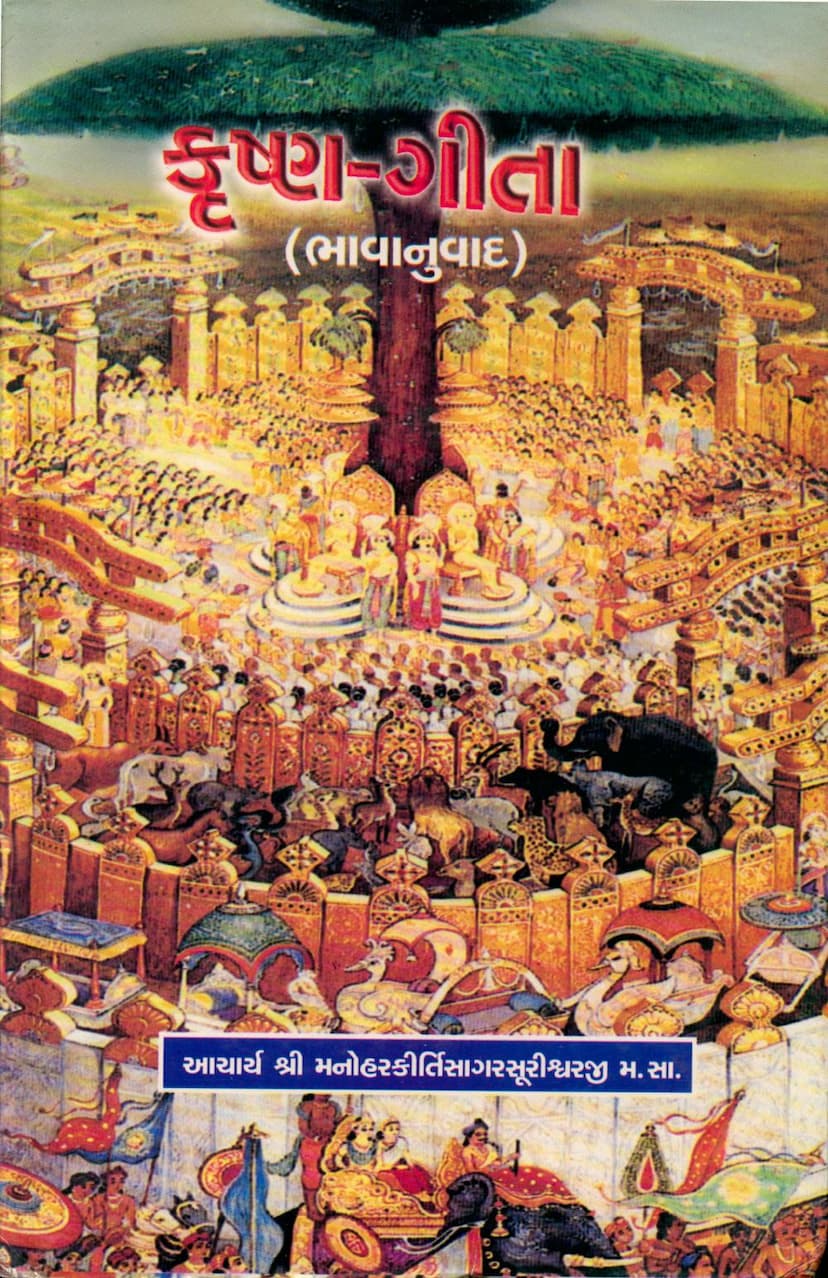Krushna Gita
Added to library: September 2, 2025

Summary
Here's a comprehensive summary of the Jain text "Krushna Gita" (Krishna Gita), based on the provided pages:
Overview:
The text "Krushna Gita" (or "Krisna Geeta" as also spelled) is a Gujarati Bhavanuvaad (interpretive translation) of a Sanskrit text, authored by Acharya Shree Manohar Kirti Sagar Surishvarji M.S. It is published by Shri Mad Budhisagar Suri Jain Samadhi Mandir, Vijapur. The work is dedicated to the spiritual achievements and teachings of Acharya Shree Budhisagar Surishwarji Maharaj. The text draws inspiration from the teachings of the Tirthankaras, particularly Lord Neminath, and emphasizes the pursuit of liberation (Moksha) through spiritual understanding and practice.
Core Themes and Teachings:
The "Krushna Gita" delves into various fundamental principles of Jain philosophy and spiritual practice, as interpreted and presented by Acharya Manohar Kirti Sagar Surishvarji. Key themes include:
- The Nature of the Soul (Atma): The text repeatedly emphasizes that the soul (Atma) is eternal, unchanging, and distinct from the physical body. It is the true self, the ultimate reality, and is inherently pure and powerful. The soul is described as the abode of infinite virtues and is essentially identical to the Supreme Soul or God (Paramatma).
- Karma and Its Effects: A significant portion of the text discusses the law of karma, explaining that all actions (karma) have consequences, leading to happiness (punya) or suffering (pap). It highlights that karma binds the soul to the cycle of birth and death (samsara), and only through the destruction of karma can liberation be achieved.
- Path to Liberation (Moksha): The text outlines the path to liberation, which involves overcoming attachments, desires, and ignorance. This path is achieved through right faith (Samyaktva), right knowledge (Samyagdarshan), right conduct (Samyakcharitra), and right effort (Samyakprayaas). The emphasis is on inner purification, detachment from worldly pleasures, and unwavering devotion to the soul's true nature.
- The Importance of Right Conduct (Sadachar): The Bhavanuvaad stresses the necessity of righteous actions, virtuous conduct, and ethical living. It advocates for non-violence (Ahimsa) in thought, word, and deed, compassion, forgiveness, and self-control.
- Detachment and Equanimity: The text promotes detachment from worldly possessions and experiences, advocating for equanimity in the face of happiness and sorrow. Maintaining a balanced perspective, free from excessive joy or grief, is crucial for spiritual progress.
- The Role of the Guru: The importance of a spiritual guide (Sadguru) is highlighted as essential for understanding the true nature of the soul and navigating the spiritual path.
- Jain Dharma as a Universal Path: The text positions Jainism as a universal and eternal religion, capable of providing solutions to all of humanity's problems. It emphasizes its core principles of Ahimsa, Satya, Aparigraha, and Brahmacharya as timeless and universally applicable.
- The Concept of 'Jain': The text elaborates on what it means to be a 'Jain,' emphasizing that it's not merely a label but a state of being characterized by inner purity, detachment, right knowledge, and righteous conduct. A true Jain is one who has conquered inner passions and achieved self-realization.
- The Importance of the Soul's Purity: The text underscores that the soul's purity is paramount. Any impurity or attachment, whether to the body, possessions, or worldly desires, creates karma and leads to suffering. True liberation comes from realizing the soul's inherent purity.
- The Meaning of Dharma: Dharma is described not just as rituals but as the inherent nature of reality, the path of righteousness, and the means to spiritual upliftment. It involves living in accordance with one's true nature and universal principles.
- The Significance of Rituals and Devotion: While emphasizing inner realization, the text also acknowledges the role of devotion (Bhakti) and certain practices in spiritual progress. Devotion to the Tirthankaras and spiritual guides is encouraged.
Specific Mentions and Structure:
- Dedication to Acharya Shree Budhisagar Surishvarji Maharaj: The text honors the spiritual legacy and immense contribution of Acharya Shree Budhisagar Surishvarji Maharaj, highlighting his extensive spiritual writings and realization.
- Inspiration from Acharya Shree Subodhsagar Surishvarji Maharaj: The Bhavanuvaad is also blessed by the blessings of Acharya Shree Subodhsagar Surishvarji Maharaj.
- Praise for the Translator: Acharya Shree Manohar Kirti Sagar Surishvarji M.S. is lauded for his profound translation, which makes the profound Sanskrit teachings accessible in Gujarati.
- Catalogue of Works: Page 7 onwards lists a vast number of works published under the "Shrimad Budhisagarsuri Granth Mala," showcasing the prolific output of spiritual literature.
- Biographical Sketch: Pages 10-20 offer a biographical glimpse into the life of Acharya Shree Budhisagarji Maharaj, detailing his early life, his spiritual awakening, his renunciation, his scholarly achievements, and his impactful preaching. It highlights key events and transformations in his life.
- Thematic Progression: The text often moves through philosophical discourse, explaining concepts like the nature of the soul, karma, liberation, and the path to achieve it. It draws parallels with concepts from other traditions (though always reframing them within a Jain context) to illustrate its points.
- Emphasis on Inner Transformation: A recurring theme is the necessity of inner transformation over mere external show. True spirituality lies in the purity of one's thoughts, intentions, and actions.
Conclusion:
"Krushna Gita" is presented as a guide for spiritual seekers aiming for self-realization and liberation. It serves as a commentary on the profound spiritual truths, urging readers to delve into the teachings through study, contemplation, and meditation. The text encourages a life of virtue, detachment, and selfless service, ultimately leading to the highest spiritual state.